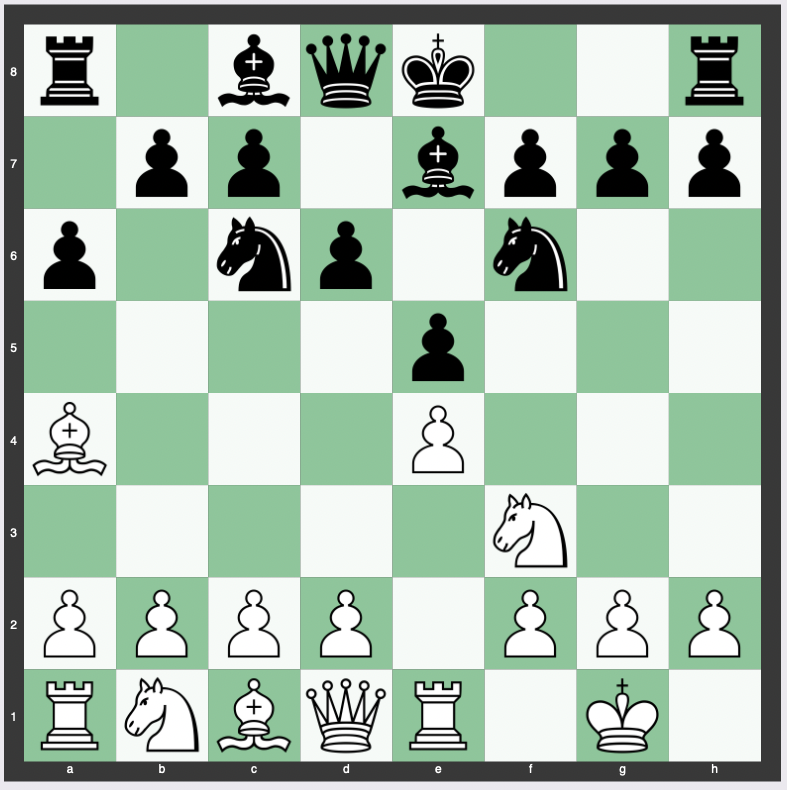The Averbakh Variation is a fascinating and complex line in the Ruy Lopez, one of the most enduring and respected chess openings.
Named after the Russian Grandmaster Yuri Averbakh, this variation has been explored by many top players and offers rich strategic possibilities.
Here we look into the move order, theory, strategy, variations, history, and its suitability for different levels of players, as well as its frequency at the Grandmaster level.
Move Order of the Averbakh Variation of the Ruy Lopez
- e4 e5
- Nf3 Nc6
- Bb5 a6
- Ba4 Nf6
- O-O Be7
- Re1 d6

This sequence of moves defines the Averbakh Variation within the Ruy Lopez.
Theory, Strategy, and Purpose of the Averbakh Variation of the Ruy Lopez
The Averbakh Variation is characterized by a solid and somewhat passive setup for Black.
White aims to exert pressure on the e5 pawn and the knight on c6.
Black’s d6 move supports the central pawn and prepares to develop the pieces harmoniously.
The variation can lead to both tactical and strategic battles, depending on the subsequent moves.
Overall the Averbakh Variation of the Ruy Lopez is evaluated at approximately +0.50 to +0.70 for white.
Sub-Variations of the Averbakh Variation of the Ruy Lopez
Several sub-variations can arise from the Averbakh Variation, depending on the players’ choices.
One common continuation is 7. c3, preparing d4 and central expansion. It is considered one of the strongest moves.
Another possibility is 7. d4, immediately challenging the center.
The bishop can also consider taking the knight via 7. Bxc6+, another strong move that rivals 7. c3 and may be the best response.
Different move orders and responses can lead to a wide array of middlegame structures and plans.
Continuation Lines of the Averbakh Variation of the Ruy Lopez
Some sample continuation lines within of the Averbakh Variation of the Ruy Lopez:
7. Bxc6+
7. Bxc6+ bxc6 8. d4 Nd7 9. dxe5 dxe5 10. Qd3 O-O 11. Qc3 f6
7. Bxc6+ bxc6 8. d4 Nd7 9. dxe5 Nxe5 10. Nxe5 dxe5 11. Qe2 O-O 12. Be3 a5 13. a4 Ba6 14. Qh5 Bd6 15. Nd2
7. Bxc6+ bxc6 8. d4 exd4 9. Nxd4 Bd7 10. c4 c5 11. Nf5 Bxf5 12. exf5 O-O 13. Bd2 Rb8 14. b3 d5 15. cxd5 Nxd5 16. Nc3 Bf6 17. Qf3
7. Bxc6+ bxc6 8. d4 exd4 9. Nxd4 Bd7 10. c4 O-O 11. Nc3 Re8 12. Qf3 h6 13. Bf4 c5 14. Nf5 Bxf5 15. exf5 Qd7 16. g4 Nh7 17. Nd5 Bf6 18. Rad1 Bxb2 19. Rb1 Rxe1+ 20. Rxe1
7. Bxc6+ bxc6 8. d4 exd4 9. Nxd4 Bd7 10. c4 O-O 11. Nc3 Re8 12. Qf3 Bg4 13. Qd3 Bd7 14. h3 Bf8 15. Bf4 Nh5 16. Bh2 Qg5
7. c3
7. c3 b5 8. Bc2 O-O 9. h3 Re8 10. d4 Bb7 11. a3 Nb8 12. Bg5 Nbd7 13. Nbd2 c5 14. Nf1 cxd4 15. cxd4 exd4 16. Nxd4 Qb6
7. c3 O-O 8. d4 b5 9. Bc2 exd4 10. cxd4 Nb4 11. d5 c5 12. dxc6 Bg4 13. Nc3 Nxc6 14. h3 Bxf3 15. Qxf3 Nd4 16. Qd1 Nxc2
7. c3 O-O 8. h3 b5 9. Bc2 Re8 10. d4 Bb7 11. a3 Nb8 12. Bg5 Nbd7 13. Nbd2 h6 14. Bh4 c5 15. a4 Nh5
7. c3 O-O 8. h3 b5 9. Bc2 Bb7 10. d4 Re8 11. Nbd2 Bf8 12. d5 Ne7 13. b3 c6 14. c4 Ng6 15. Nf1 Rc8 16. Ng3 Qc7 17. Bg5
History of the Averbakh Variation of the Ruy Lopez
The Averbakh Variation is named after Yuri Averbakh, a prominent Russian chess player, and theoretician.
It has been played since the mid-20th century and has been explored by many top players.
The variation has contributed to the rich tapestry of Ruy Lopez theory and continues to be a subject of study and exploration.
Is the Averbakh Variation of the Ruy Lopez Good for Beginners or Intermediates?
The Averbakh Variation can be suitable for both beginners and intermediate players.
For beginners, it offers a solid and straightforward development plan.
For intermediate players, it provides opportunities to explore deeper strategic ideas and tactics.
How Often Is the Averbakh Variation of the Ruy Lopez Played at the Grandmaster Level?
The Averbakh Variation is not as popular at the Grandmaster level as some other lines in the Ruy Lopez.
However, it has been employed by some top players as a surprise weapon or in specific tournament situations.
Its strategic richness ensures that it remains an interesting option at the highest levels of play.
Ruy Lopez: Averbakh Variation
Conclusion
The Averbakh Variation in the Ruy Lopez (Spanish Game) is a fascinating and multifaceted line that offers a wide range of strategic and tactical possibilities.
Its history, variations, and suitability for different levels of players make it an enduring part of chess opening theory.
While not as prevalent at the Grandmaster level as some other lines, the Averbakh Variation continues to be a valuable tool in the arsenal of many players, offering a blend of solidity and complexity that can lead to rich and engaging battles on the chessboard.


